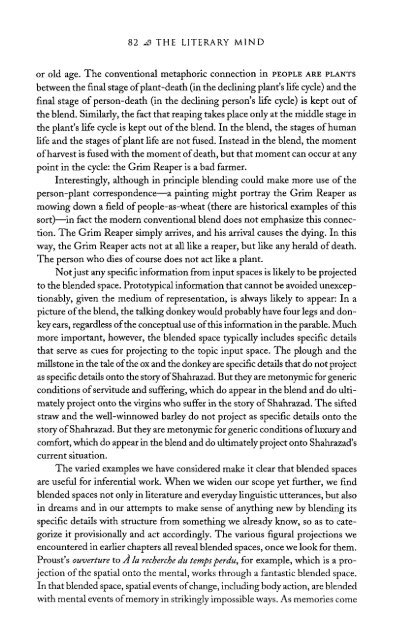The Literary Mind.pdf
The Literary Mind.pdf
The Literary Mind.pdf
Create successful ePaper yourself
Turn your PDF publications into a flip-book with our unique Google optimized e-Paper software.
82 THE LITERARY MIND<br />
or old age. <strong>The</strong> conventional metaphoric connection in PEOPLE ARE PLANTS<br />
between the final stage of plant-death (in the declining plant's life cycle) and the<br />
final stage of person-death (in the declining person's life cycle) is kept out of<br />
the blend. Similarly, the fact that reaping takes place only at the middle stage in<br />
the plant's life cycle is kept out of the blend. In the blend, the stages of human<br />
life and the stages of plant life are not fused. Instead in the blend, the moment<br />
of harvest is fused with the moment of death, but that moment can occur at any<br />
point in the cycle: the Grim Reaper is a bad farmer.<br />
Interestingly, although in principle blending could make more use of the<br />
person-plant correspondence—a painting might portray the Grim Reaper as<br />
mowing down a field of people-as-wheat (there are historical examples of this<br />
sort)—in fact the modern conventional blend does not emphasize this connection.<br />
<strong>The</strong> Grim Reaper simply arrives, and his arrival causes the dying. In this<br />
way, the Grim Reaper acts not at all like a reaper, but like any herald of death.<br />
<strong>The</strong> person who dies of course does not act like a plant.<br />
Not just any specific information from input spaces is likely to be projected<br />
to the blended space. Prototypical information that cannot be avoided unexceptionably,<br />
given the medium of representation, is always likely to appear: In a<br />
picture of the blend, the talking donkey would probably have four legs and donkey<br />
ears, regardless of the conceptual use of this information in the parable. Much<br />
more important, however, the blended space typically includes specific details<br />
that serve as cues for projecting to the topic input space. <strong>The</strong> plough and the<br />
millstone in the tale of the ox and the donkey are specific details that do not project<br />
as specific details onto the story of Shahrazad. But they are metonymic for generic<br />
conditions of servitude and suffering, which do appear in the blend and do ultimately<br />
project onto the virgins who suffer in the story of Shahrazad. <strong>The</strong> sifted<br />
straw and the well-winnowed barley do not project as specific details onto the<br />
story of Shahrazad. But they are metonymic for generic conditions of luxury and<br />
comfort, which do appear in the blend and do ultimately project onto Shahrazad's<br />
current situation.<br />
<strong>The</strong> varied examples we have considered make it clear that blended spaces<br />
are useful for inferential work. When we widen our scope yet further, we find<br />
blended spaces not only in literature and everyday linguistic utterances, but: also<br />
in dreams and in our attempts to make sense of anything new by blending its<br />
specific details with structure from something we already know, so as to categorize<br />
it provisionally and act accordingly. <strong>The</strong> various figural projections we<br />
encountered in earlier chapters all reveal blended spaces, once we look for them.<br />
Proust's ouverture to A la recherche du temps perdu, for example, which is a projection<br />
of the spatial onto the mental, works through a fantastic blended space.<br />
In that blended space, spatial events of change, including body action, are blended<br />
with mental events of memory in strikingly impossible ways. As memories come















